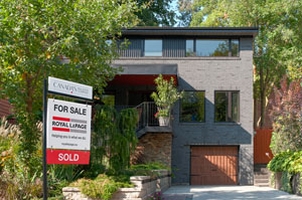Balance expected to return to market in second half of the year
 TORONTO, July 9, 2020 – According to the Royal LePage House Price Survey and Market Survey Forecast released today, the aggregate[1] price of a home in Canada increased 6.8 per cent year-over-year to $673,072, in the second quarter. Once provinces allowed regular real estate activity to resume, demand surged in many markets. Inventory levels, already constrained pre-pandemic, have failed to keep pace.
TORONTO, July 9, 2020 – According to the Royal LePage House Price Survey and Market Survey Forecast released today, the aggregate[1] price of a home in Canada increased 6.8 per cent year-over-year to $673,072, in the second quarter. Once provinces allowed regular real estate activity to resume, demand surged in many markets. Inventory levels, already constrained pre-pandemic, have failed to keep pace.
“Home prices shot up in the second quarter as a crush of buyers entered the market, attracted by extremely low interest rates and the perception of bargains to-be-had,” said Phil Soper, president and CEO of Royal LePage. “Across Ontario and Quebec in particular, the demand for housing outpaced the growth in supply, especially in the early weeks post-lockdown. The surge in the number of first-time buyers was felt acutely, as these housing consumers soaked up supply without contributing to it.”
Soper continued, “We are now seeing sellers return to the market in key supply-constrained regions in numbers sufficient to meet demand. Home buyers should enjoy more reasonable conditions with stable prices and improved selection in the second half of the year.”
The Royal LePage National House Price Composite is compiled from proprietary property data in 64 of the nation’s largest real estate markets. When broken out by housing type, the median price of a standard two-storey home rose 8.0 per cent year-over-year to $794,392, while the median price of a bungalow increased 3.9 per cent to $550,289. The median price of a condominium increased 5.3 per cent year-over-year to $503,983.
“COVID-19 shaped the real estate market during the second quarter in every possible way,” said Soper. “As consumers and Realtors®[2] complied with April’s shelter-at-home directives and only urgent housing needs were serviced, sales volumes plummeted to one-third of normal in our largest cities. As the reality of extended and potentially permanent work-from-home employment sunk in, people pondered both the location and size of their homes. Simply put, larger homes in smaller communities have become more fashionable. As competition for these properties heats up, bidding wars are more common in what were our quieter cities and towns.”
Across Canada, the 11 regions to post the highest year-over-year gains in median home price were in Ontario. In order, Mississauga (13.5%), Windsor (12.2%), Markham (11.9%), Ottawa (11.7%), Niagara/St.Catharines (11.3%), London (10.5%), Brampton (10.4%), Toronto (10.2%)/Greater Toronto Area (10.0%), Guelph (9.9%), Kitchener/Waterloo/Cambridge (9.8%), and Milton (9.7%).
Immigration
Immigration has been disrupted by pandemic travel restrictions, with the impact to real estate markets varying across regions and housing segments. Royal LePage’s 2019 Newcomer study showed that upon arriving in Canada, only 15 per cent of newcomers purchase their first home. The average time period after which newcomers will purchase a property is three years after arriving in Canada.[3]
“Our research shows that many of the newcomers to our nation who intended to buy a home this year have already been living in Canada for three or more years,” said Soper. “A short-term drop in the number of new immigrants and international students will not directly impact home sales in the current year, as most newcomers will rent their first home. We may feel the impact of fewer new Canadians in our residential investment market with less demand for rental units. Mitigating the impact of this trend is a surge in first-time buyer interest. Some landlords may choose to sell to eager millennial families if rental demand softens.”
Lengthy Economic Recovery and Revised Royal LePage Forecast
As home sellers return to the market, inventory levels are expected to rise, relieving the acute upward pressure on home prices that characterized the supply-constrained second quarter of 2020. Uncertainty clouds Canada’s real estate outlook as a lengthy recovery for the Canadian and world economies is expected. The negative impact on home prices should be muted by the balanced nature of Canadian housing, as chronic housing supply shortages offset dampened medium-term demand.
Royal LePage has revised its forecast slightly upward, with the national aggregate price expected to end 2020 up 2.3 per cent to $663,000 in the fourth quarter compared the same period in 2019.
For FULL ARTICLE and the Regional Summaries click HERE.
